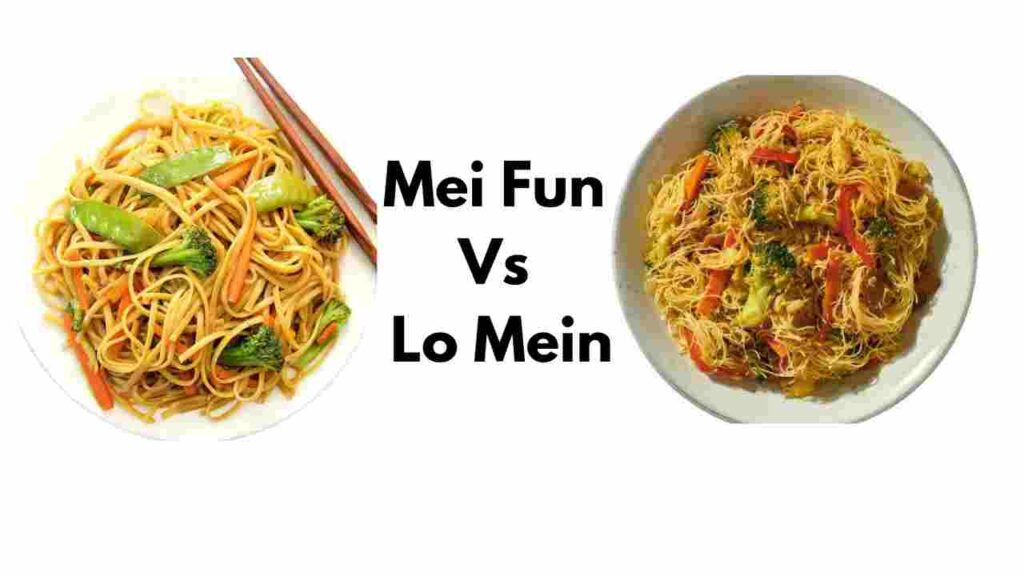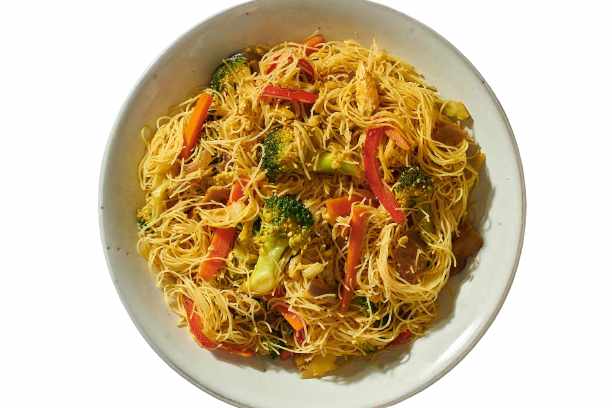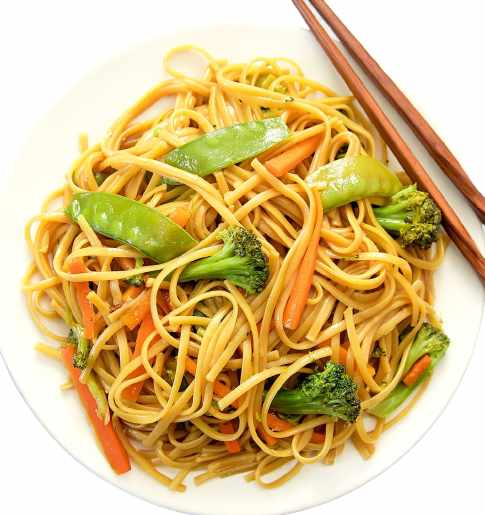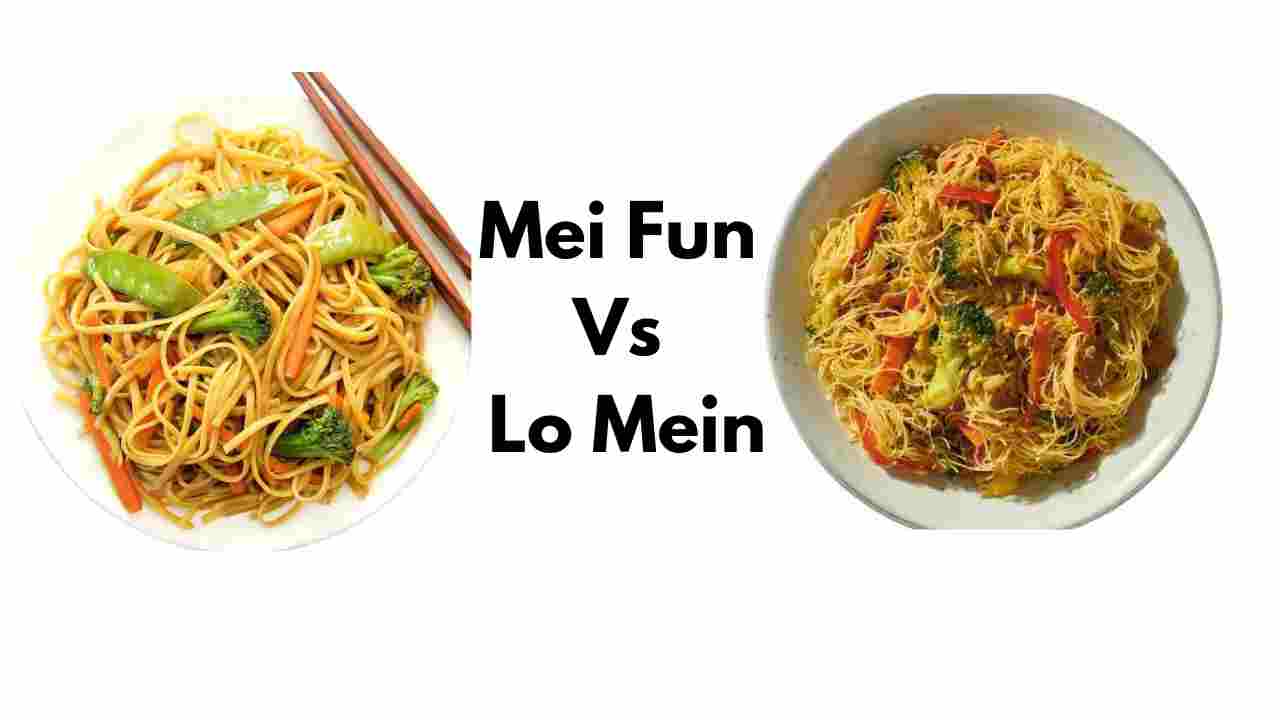People often get confused between Mei Fun and Lo Mein, and in this guide, I will be telling you about all the differences between Mei Fun vs Lo Mein, so keep reading this article till the end to know.
Are you by any chance new to Chinese cuisine and are confused between mei fun and lo mein? Or maybe you are absolutely sure that you can tell the difference between the two? But do you? Keep reading the article and find out for yourself.
It is quite common to confuse mei fun and lo mein. Believe me, I have been there! But over time I understood the difference between these two Chinese dishes.
Let us try to understand the subtle differences between Mei Fun and Lo Mein

Comparison At A Glance | Mei Fun Vs Lo Mein
| Characteristic | Mei Fun | Lo Mein |
| Basic ingredients | Rice flour and water | Wheat and eggs |
| Cooking time | 5 to 6 minutes | 2 to 3 minutes |
| Color | Whitish color | Yellowish color |
| Texture | Crunchy | Sticky |
Mei Fun – The Noodle

Mei Fun is a Chinese dish that consists of noodles made using rice flour and water. This dish originated in China but is now commonly found across all Chinese restaurants everywhere these days.
I have observed that the key ingredients are rice and water, but the restaurants offer many variations based on the ingredients used.
Mei Fun has a light taste and a soft whitish color that mostly resembles rice (as it is mainly made from rice).
I have found that Mei Fun is commonly served as stir-fried noodles, in soups, and spring rolls. You can also find that Mei Fun noodles can contain beans, wheat, and eggs as the noodle ingredients.
Mei Fun is usually found as dried bundles in the market as rice vermicelli, rice sticks, or rice noodles.
For people with gluten allergies, opt for the one made completely from rice.
Lo Mein – The Noodle

Lo Mein is not only a different type of noodle but also is prepared in a different way.
Le Mein is primarily made from wheat and eggs.
Since the key ingredient here is wheat, Lo Mein contains gluten.
I would describe these noodles to be slightly yellowish in color and also thicker in consistency.
Because they are thick, they absorb most of the flavorful sauces they are prepared in and are very delicious to taste.
The word “lo” in Lo Mein means to toss, and that just describes the way these noodles are prepared – by tossing them in a saucepan or a wok. Of course, initially, they need to be partially boiled in water.
Major Differences Between Mei Fun and Lo Mein
Now, based on the individual description of these noodles, you might have gotten a rough idea about what they are. Here are some points to understand the subtle differences between the two.
Basic Ingredients Used
Mei Fun noodles are made from rice and water. Sometimes known as rice vermicelli, this is the most traditional type of noodle that you can find.
On the other hand, Lo Mein is a type of noodle that uses wheat and eggs as base ingredients.
As long as Mei Fun noodles list rice and water as their main ingredients, they can be used easily by gluten-intolerant people, people with protein allergies, and vegans.
On the other hand, since Lo Mein contains wheat, it is better if you avoid it if you have any gluten intolerance. The use of eggs renders it useless for people who are on a vegan diet. For vegans who can tolerate gluten, you might want to look for wheat and water preparations.
Cooking Time
Mei Fun noodles are usually dried and need to be parboiled in water for about 5 to 6 minutes before they can be used in other dishes. Make sure not to over boil them as they need to be added to other dishes where their gradual cooking will continue and you will get the desired consistency.
Lo Mein noodles need 2 to 3 minutes of time to be boiled in water for optimum consistency. Again, just like Mei Fun, make sure not to over boil them. Lo Mein is usually used in stir-fry recipes, where they will absorb the flavor and moisture from sauces. Overboiling them in the first place will make your final dish slightly soggy.
Appearance
I find it easier to tell the difference between Mei Fun and Lo Mein based on their appearance.
Mei Fun has a faint, light, and whitish color, mainly because it is made from rice flour.
Lo Mein, on the other hand, has a yellowish color.
It is super easy for me to tell apart these two from each other simply based on their colors.
Taste
If you are looking for a milder taste, you should go for Mei Fun. It has mild sweetness as it is a rice-based preparation.
On the contrary, if you are looking for a full-blown richer taste, you must opt for Lo Mein noodles. The wheat noodles also end up absorbing the other flavors of the dish and sauces thereby giving a nice full taste to your tongue palate.
Texture
I have found Mei Fun to be slightly crunchy even after parboiling it. The reason behind this is that it is a dry noodle type.
Mei Fun can get slightly sticky due to the rice present in starch. You must use some oil while boiling them so that the strands don’t stick together.
Lo Mein has a softer texture and is not crunchy at all.
Dishes Made
Both Mei Fun and Lo Mein, are used as accompaniment. They are never served as a whole main dish.
Mei Fun is usually used as a crunchier addition to spring rolls, vegetables, and other dishes. Because of their crunchy nature, they can also go well with stir-fries as well.
Lo Mein on the other hand, because of the ability to absorb more flavors and sauces, is best used with meat dishes, soups, and even stir fries too.
Conclusion
Both Mei Fun and Lo Mein noodles impart a unique cuisine experience. If you are not gluten-intolerant or allergic to protein, I would recommend you try out both of these types of noodles.
Be it the fragile, delicate, and mild Mei Fun or the thick, flavorful Lo Mein, both these noodles will definitely give you the authentic Chinese cuisine experience that you crave for.

